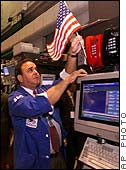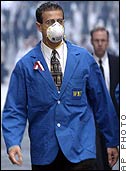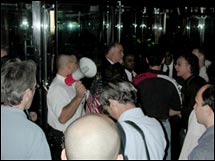|
Life returns to Wall Street
|
 |
September 17, 2001: 7:01 p.m. ET
Downtown workers head back with concern, determination; some still in shock
By Staff Writers Shelly Schwartz and Martine Costello
|
NEW YORK (CNNfn) - They shuffled back to work Monday, with somber faces and American flags, distributed by volunteers at the South Street Seaport Ferry.
Many used surgical masks and make-shift bandanas to filter the air as they passed the still-smoldering site of the World Trade Center. In a state of shock they weaved their way through police tape, bomb squads and barricades.
|

|
VIDEO
|
|
 CNNfn's Patricia Sabga reports on the mood on Wall Street. CNNfn's Patricia Sabga reports on the mood on Wall Street. |
|
Real
|
28K
|
80K
|
|
Windows Media
|
28K
|
80K
|
|
For those who work in lower Manhattan, it was anything but business as usual.
"It's spooky," said John Garrison, a city worker and member of Service Employees Union International Local 32, who planned to walk more than a mile to his office to avoid being underground. "I'm not ready. I don't think anyone is ready. But we've got to go back."
On street corners, amid the ash and power generators, friends and colleagues huddled to exchange accounts of last Tuesday's tragedy � to� reflect on all that was lost. Some, too, voiced concern for their own safety and expressed anger at being asked to return to Manhattan less than a week after the attack.
"I think they should let us go back home," said Yvette Collins, who works for Continental Stock Transfer off Wall Street.� "We're too close to a lot of landmark buildings here. The smoke is bad. It smells. They say there's no asbestos in the air, but I think they're lying. I want to leave. I have a child."
Inside the NYSE
From the floor of the New York Stock Exchange, ribbons in red, white and blue adorned each coat and flags hung from the desks. Traders and specialists, many wearing patriotic colors, hugged and slapped each other on the back � happy to see one another alive and well.�
"Seven people we know are dead," one exchange worker said as she stood by the elevator.
For one man, wearing a blue jacket and hunched over a computer, it was too much to bear. His shoulders heaved as he stood before a crowd of dignitaries at the opening bell.
As the markets failed to find its footing throughout the day, the Dow Jones industrial average closed sharply lower, shedding nearly 700 points.
Brokers noted the selling came from all directions, a clear sign investors remain on edge in the wake of the disaster that toppled the World Trade Center. �
"The numbers in the market are atrocious, given that you had a cut by the Fed today," said Peter Kenny, president of Peter C. Kenny & Co. brokerage house. "It's very emotional to see these catastrophic events happening not far away."
One broker said he witnessed selling across the board, but no real signs of panic.�
Theodore Weisberg, president of Seaport Securities brokerage, said he suspects the specialists, whose job it is to ensure buy and sell orders are balanced, dipped into their own capital to prevent even further losses Monday.
| |

|
|
Trader Alex Maio, right, with Prudential Securities, puts up an American flag on the New York Stock Exchange trading floor prior to the opening bell | |
But he notes, too, that his clients, high net worth individuals and institutions, bucked the selling trend Monday by buying stocks � including the struggling airline sector.
"We've had mostly buy orders," Weisberg said as he flipped through the stack of orders in his hand. "The key to making money long term is zigging when everyone else is zagging. It's being a contrarian."
Despite Monday's hefty losses on the big board, brokers expressed an optimistic long term outlook.�
Kenny said he believes the eight consecutive interest rate cuts by the Federal Reserve would eventually help markets rebound. "People are really doing their jobs and doing them well (on the exchange floor)," he said. "There's a sense of pride in terms of what we're doing....The overriding feeling is that we're going to persevere."
Added Jay Mahoney, director of Wagner Stott, from a section of the exchange known as the extended blue room: "I think we've been successful showing that this market is still functioning."
And NYSE Chairman Richard Grasso said the U.S. economy remains the strongest in the world. Short-term turbulence, he said, is of little consequence to future trends.
"Today's market is not important," Grasso said. "It's the market a year from now, two years from now [that is important]."

|
|
|
A trader wears a protective mask to block out the smoke. | |
Back to work
Meanwhile, delis and coffee shops like Trader's Caf� and Champs Gourmet Deli, which cater to the Wall Street crowd, reopened this morning after tackling clean-up duty over the weekend. Some shops closer to the World Trade Center site remained closed as they wait for water service to be restored.
"We came in yesterday," said Demetrius Liberatos, owner of Traders' Caf� near the New York Stock Exchange. "It was a mess. There was a lot of dust. And there's not much business today. So many of the roads are still blocked." He said up to 50 percent of his lunch delivery business came from the World Trade Center towers.
Another downtown shopkeeper, George Panagiotopoulos said he expects business to be negatively affected by the tragic loss of New York's tallest buildings. The owner of Heart to Heart Florists on Beaver Street, who provided centerpieces last month for a wedding at Windows on the World restaurant at the top of One World Trade Center, said many of his clients were building tenants. At least five of his customers remain unaccounted for.�
| |

|
|
Security guards corralled people to shout instructions. | |
"It's sad," he said. "They were my clients, but also my friends. We just don't know who's on the list and who's not."
Everywhere there was top-level security.
Teams of firefighters, police and the National Guard stood sentinel on every corner below Canal Street, steering foot traffic to open roads and checking pedestrian IDs, including drivers' licenses.
Amid the office paper and soot still blanketing the roads, bomb-sniffing dogs made their way through the crowds. One delivery man was asked to put a box of hot coffee cups through an X-ray machine at the New York Stock Exchange entrance. And a CNNfn.com reporter on the scene had to pass through several police checks before being admitted into the building.
No one was taking chances.
Kenny noted the heightened security, which escaped no one, contributed to Wall Street's plunge, rattling NYSE traders even before they walked through the door.
"It does weigh on you what you had to do to get here," he said.
Kenny, who had friends who perished last week, said he can't help thinking about their last frightening moments and when they must have realized they wouldn't make it out alive.
"How unbelievably scary it must have been," he said. "I keep thinking how they must have felt."
At many of the larger office buildings, including SG Cowen on Front Street, security guards corralled employees outside building lobbies using megaphones to shout instructions. Two forms of ID were required to gain entrance as employees were ushered in 10 at a time.
"I have mixed emotions," said Terry McLaughlin, a money manager and chief investment officer for Ashland Management. "I still look at planes differently than before. And you keep thinking what might be next. But people will step up to the plate. Our economy will keep going." 
|
|
|
|
|
 |

|

